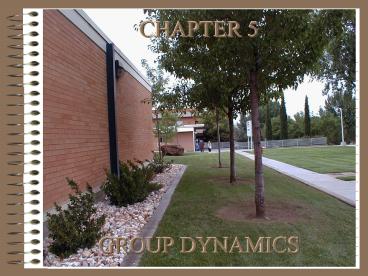CHAPTER 5 GROUP DYNAMICS - PowerPoint PPT Presentation
1 / 16
Title:
CHAPTER 5 GROUP DYNAMICS
Description:
CHAPTER 5 GROUP DYNAMICS Group two or more people who interact on the basis of shared social structure and who recognize mutual dependency (Brinkerhoff, p. 101). – PowerPoint PPT presentation
Number of Views:475
Avg rating:3.0/5.0
Title: CHAPTER 5 GROUP DYNAMICS
1
CHAPTER 5GROUP DYNAMICS
2
Group
- two or more people who interact on the basis of
shared social structure and who recognize mutual
dependency (Brinkerhoff, p. 101).
3
Groups can be distinguished from
- Crowds people who are temporarily clustered
together. - Categories people who share a characteristic
(p. 101).
4
Social Processes are the forms of interaction
through which people relate to one another they
are the dynamic aspects of society (p. 98)
5
Four Types of Social Processes
- Exchange
- Cooperation
- Competition
- Conflict
6
Exchange is voluntary interaction from which all
parties expect some reward (Brinkerhoff, p. 98).
7
Norm of reciprocity the expectation that
people will return favors and strive to maintain
a balance of obligation in social relationships
(p. 98).
8
Cooperation is interaction that occurs when
people work together to achieve shared goals (p.
99)
9
Competition is a struggle over scarce resources
that is regulated by shared rules (p. 99).
10
Conflict is a struggle over scarce resources
that is not regulated by shared rules (p. 100)
11
Primary groups are characterized by intimate,
face-to-face interaction (p. 101).
12
Secondary groups are formal, large, and
impersonal (p. 102)
13
TIES
- Strong ties are relationships characterized by
intimacy, emotional intensity, and sharing. - Weak ties are relationships with friends,
acquaintances, and kin that are characterized by
low intensity and intimacy (p. 108).
14
Complex organizations are large, formal
organizations with complex status networks (p.
115)
15
Webers Characteristics of Bureaucracy (p. 115-16)
- Division of labor and specialization
- Hierarchy of authority
- Rules and regulations
- Impersonal relationships
- Careers, tenure, and technical qualifications
- Efficiency
16
Criticisms of Bureaucracy (p. 117)
- Ritualism
- Alienation
- Structured Inequality































